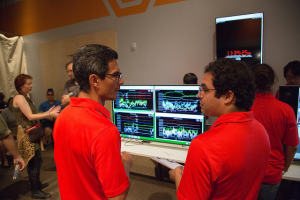The city of Houston, home of the largest medical center in the world, is known for being at the forefront of cutting-edge medical research. By partnering with Houston Methodist, a hospital at the heart of the medical center, the Cullen College of Engineering offers University of Houston students a unique opportunity to gain hands-on experience in authentic clinical environments. One example of this partnership can be found in the University of Houston/Houston Methodist Research Institute (UH/HMRI) Graduate Fellowship in Translational Research, a two-year fellowship offered to doctoral students pursuing engineering and translational biomedical research.
The award’s most recent recipient, electrical and computer engineering doctoral student Jesus G. Cruz-Garza, is currently in his second year of the fellowship researching common and unique neural patterns that occur in humans during unconstrained social interaction and artistic reflection and production. Cruz-Garza is working side-by-side with UH faculty mentor Jose Luis “Pepe” Contreras-Vidal, Hugh Roy and Lillie Cranz Cullen Distinguished Professor of electrical and computer engineering, Todd Frazier, managing director of the Methodist Hospital Center for Performing Arts Medicine, and Christof Karmonik, director of the Translational Imaging Core Facilities at HMRI.
During the first year of the fellowship, Cruz-Garza facilitated experiments to gather “in action” and “in context” normative data, or data from normally-developing individuals collected in an environment outside of the laboratory. These data collection sessions took place at various locations throughout the city of Houston, including the Menil Collection and the Children’s Museum of Houston.
Collecting normative data is an essential first step in this research, he said. Once the data is analyzed by Cruz-Garza and his fellowship mentors, it can be used to create a baseline for comparison for studying neurological disorders and treatments, he explained.
This year, Cruz-Garza is focused on developing a machine learning algorithm to interpret the collected data. “This type of data is very difficult to analyze,” he said, adding that the algorithm will work by “[helping] the computer understand what the signals mean so that the next time the computer sees the signals it can interpret them accordingly.”
Cruz-Garza moved from Mexico to Texas to pursue his Ph.D. at UH after interning with Contreras-Vidal in 2013. He said he was immediately drawn to neuroengineering because he felt the field would encourage him to grow academically and professionally.
“In neuroscience, there are many questions that are still unanswered and most of our studies are exploratory,” he said. “Everything is exciting.”
